Understanding the source of your knee pain is the first step toward effective treatment. Whether it’s a sharp pain on the side of the knee or a persistent ache under the kneecap, a knee pain location chart can help you pinpoint the problem. Experiencing knee pain in different locations can indicate various underlying conditions, from ligament injuries to arthritis.
At Memorial Pain Clinic in Tulsa, Oklahoma, we provide effective knee pain treatment to help you return to your active life as quickly as possible. If knee pain is holding you back, call 918-200-9944 or contact us online to schedule a visit and start your journey to relief.
Parts of the Knee Joint
The knee joint is an intricate system, and understanding its parts can help you figure out the cause of your knee pain. By looking at a knee pain diagnosis chart, you can see how the different parts work together to enable movement and support the knee. Each part has an important role, and problems with any of them can cause significant joint pain.
Below, we’ll break down four key areas of the knee joint to give you a better idea of what might be causing your knee pain.
Bones in the Knee
The knee joins three important bones: the femur (thigh bone), the tibia (shin bone), and the patella (kneecap). These bones form the main structure of the knee joint, holding up the body’s weight. The femur and tibia act like a hinge, allowing the knee to bend, while the patella sits at the front, protecting the knee joint and helping the leg muscles extend the leg.
Cartilage, Bursae, and Synovium
Inside the knee, cartilage (specifically the lateral meniscus) helps absorb shocks and reduces friction when you move. There are also several bursae, small fluid-filled sacs that cushion the areas where bones, tendons, or muscles rub together.
The knee is a synovial hinge joint, which means it is lined by a thin layer of connective soft tissue called the synovium. The synovium produces synovial fluid, which lubricates the knee joint and keeps movement smooth.
Knee Ligaments
Four major ligaments keep the knee stable: the anterior cruciate ligament (ACL), posterior cruciate ligament (PCL), medial collateral ligament (MCL), and lateral collateral ligament (LCL).
These ligaments connect the thigh bone to the shin bone and keep the knee from moving too far forward or sideways. Damaging these ligaments can cause severe pain and make the knee less stable.
Knee Tendons
Tendons are tough bands that connect muscles to bones, allowing the knee to move. The patellar tendon attaches the kneecap to the lower leg, and the quadriceps tendon connects the thigh muscle to the kneecap. Together, the tendons help straighten the knee, which is essential for standing, walking, and running.
Types of Knee Pain
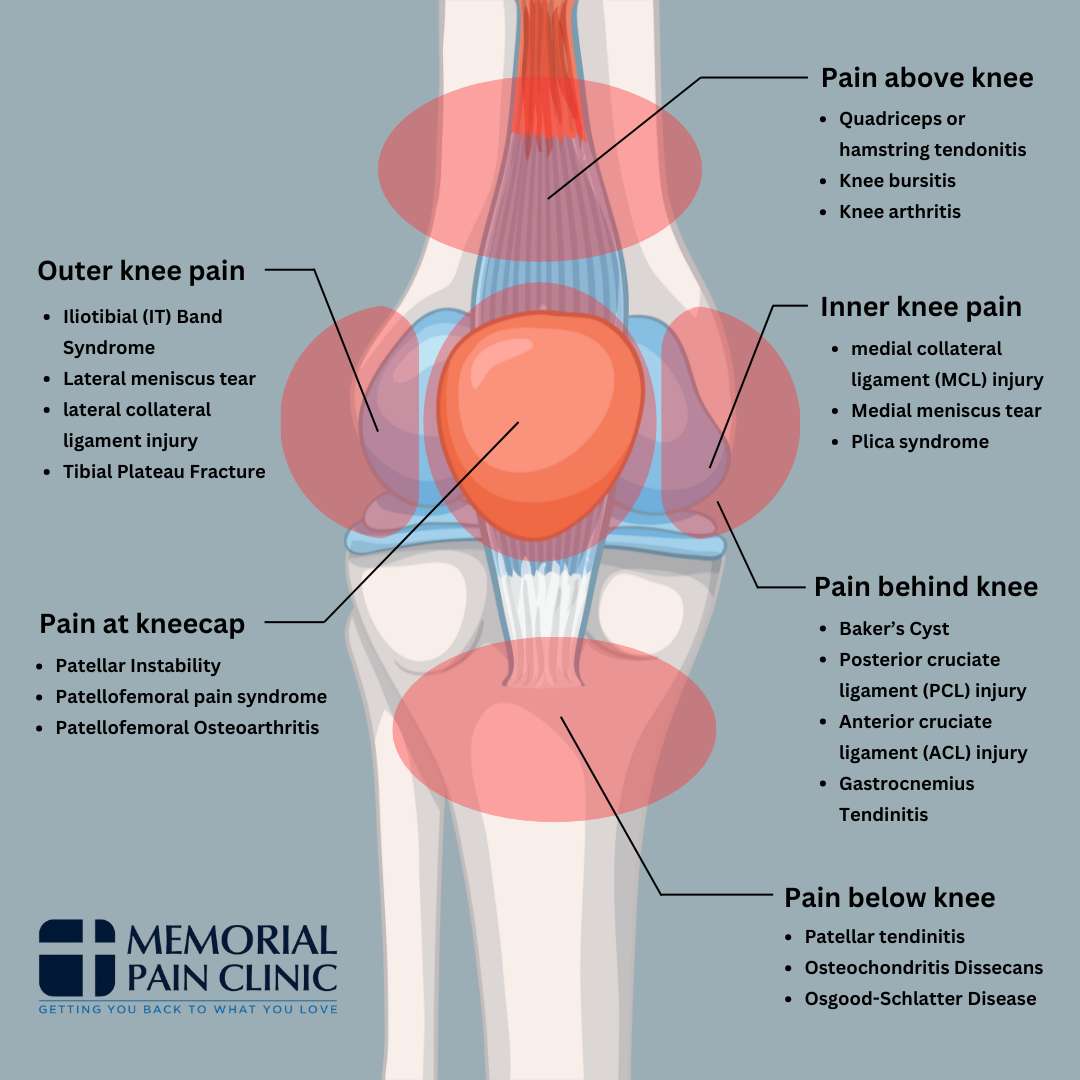
Knee pain can show up in specific areas of the knee, and where the pain is located often gives clues about what’s causing it.
Looking at a knee pain location chart can help you understand the different kinds of knee pain, whether it’s at the back of the knee (posterior knee pain), the front of the knee (anterior knee pain), on the inner side, or the outer side. Each area is linked to specific problems.
In the sections below, we’ll go over each location to help you figure out what might be causing pain in your knee.
Pain Above the Knee
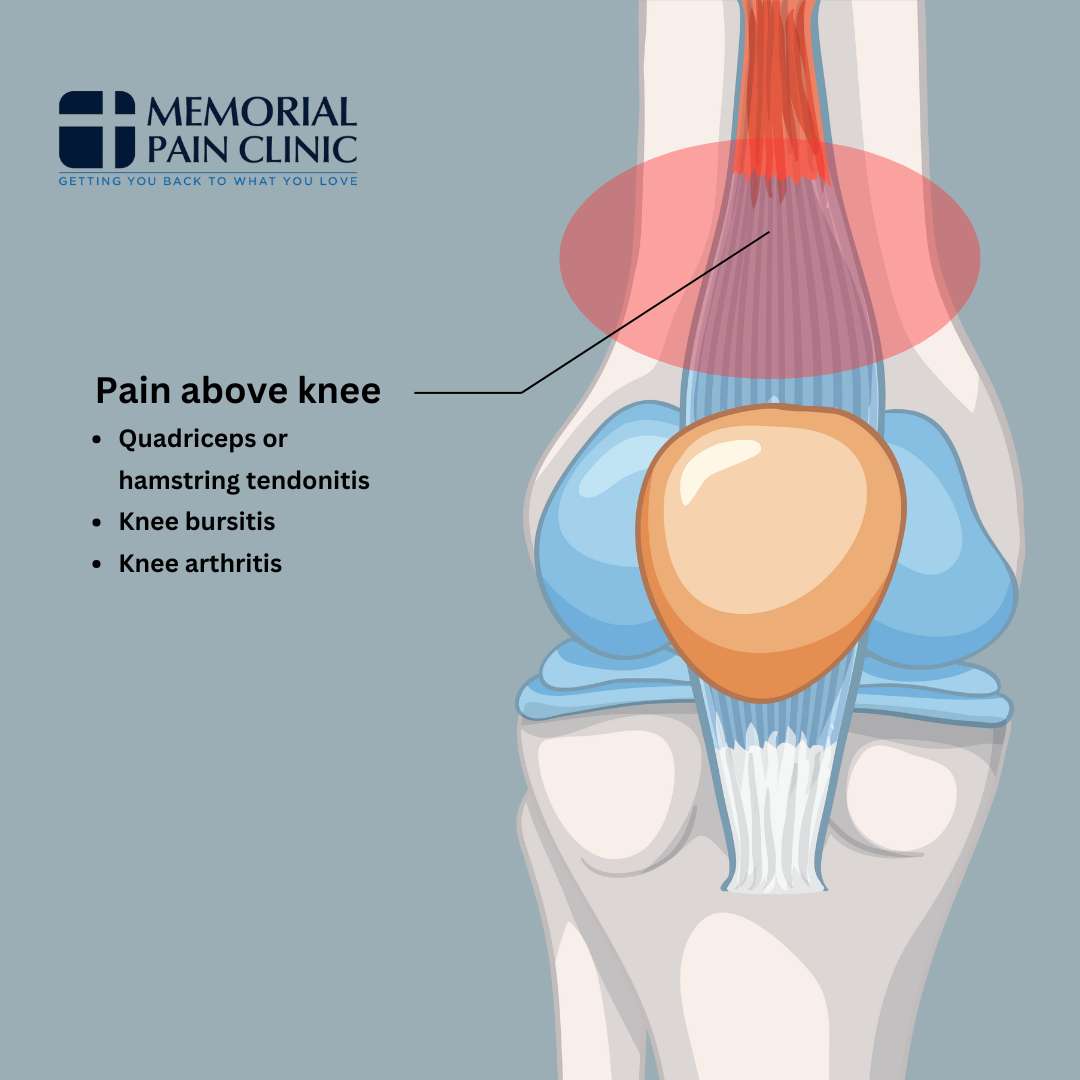
Pain above the knee is often connected to issues with the muscles, tendons, or joints near the knee. Below, we’ll look at three common causes of pain above the knee:
Knee Arthritis
Knee osteoarthritis and rheumatoid arthritis are two types of inflammatory joint disease that can cause chronic knee pain. These conditions happen when cartilage in the knees wears down, or the knee joints become inflamed, leading to pain and stiffness.
Without enough cushioning between the knee bones, every movement can become painful. At Memorial Pain Clinic, we offer arthritis treatment and management to help ease your symptoms and make daily life easier.
Knee Bursitis
Knee bursitis happens when the small, synovial fluid-filled sacs called bursae, which cushion your knee, get inflamed. This inflammation can cause pain above the knee and around the knee joint, especially when you bend or straighten your leg. Knee bursitis often comes from overuse or repetitive knee movements, leading to discomfort that can make it hard to stay active.
Hamstring or Quadriceps Tendonitis
Knee pain can occur when the tendons in the quadriceps or hamstring muscles are overworked or injured. The hamstring muscle is located at the back of your thigh, while the quadriceps tendon connects to your kneecap. If the tendons become inflamed from activities like running, jumping, or heavy lifting, it can lead to pain above the knee. Hamstring or quadriceps tendonitis can make it tough to go about your daily activities.
Pain Below the Knee
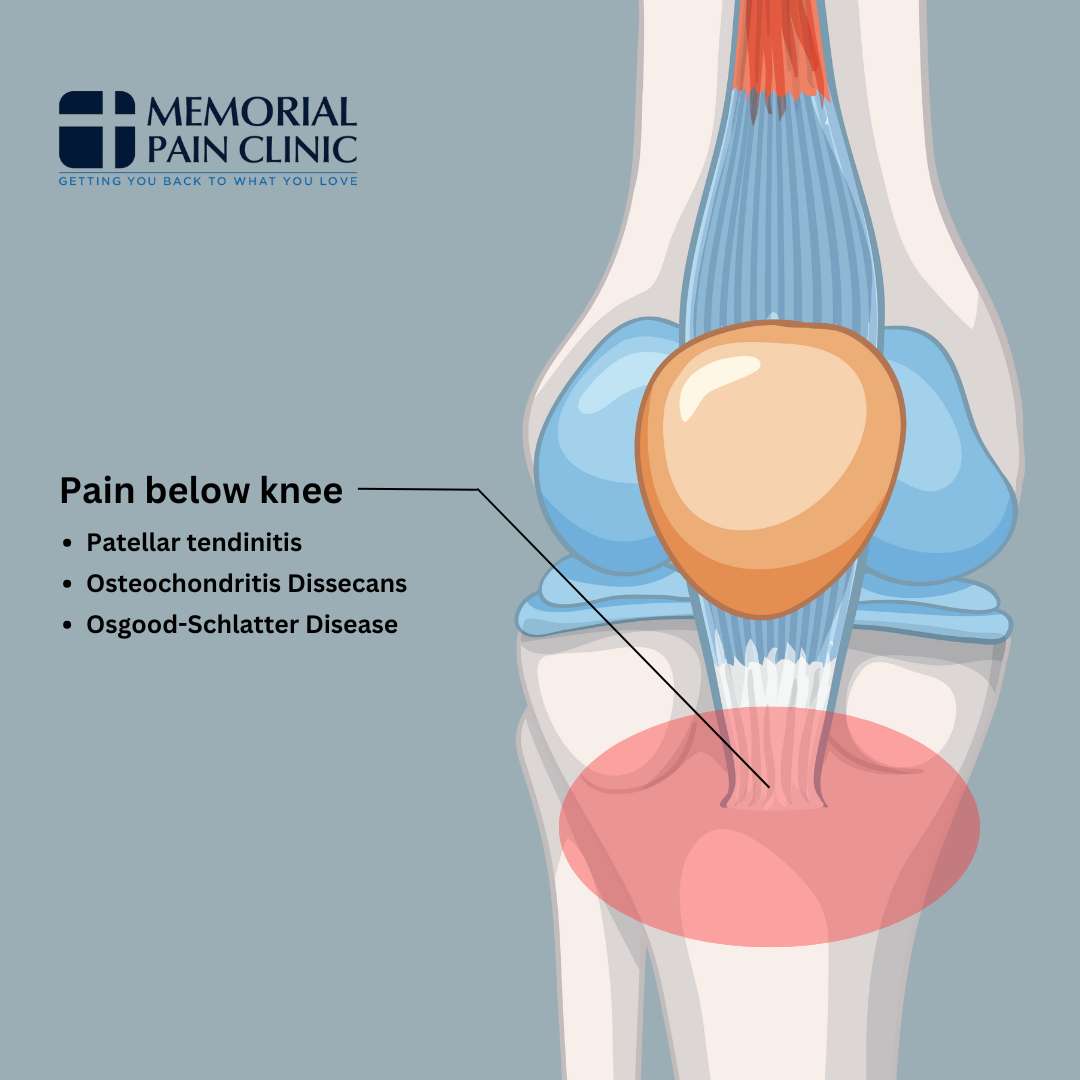
Experiencing pain below the knee is common, and it can be caused by various conditions affecting the tendons, bones, or growth plates. This knee pain location chart shows three conditions that can cause pain below the knee:
Patellar Tendinitis
Patellar tendonitis occurs when the patellar tendon, which connects the kneecap to the shin bone, becomes inflamed. This condition is commonly seen in athletes who play sports that involve frequent jumping or running, like basketball. The inflammation causes pain and tenderness just below the knee, making it difficult to perform activities that put stress on the knee.
Osteochondritis Dissecans
Osteochondritis dissecans is a joint condition where a segment of bone underneath the cartilage in a joint loses blood supply. The segment of bone and the cartilage covering it can crack and become loose. When it affects the knee, it often causes pain below the kneecap and may result in swelling or the knee giving way. This condition most commonly occurs in young athletes whose sport requires repetitive knee movements like running or jumping.
Osgood-Schlatter Disease
Osgood-Schlatter disease is a condition that typically affects growing children and teenagers, causing pain and swelling below the knee. It occurs when the growth plate at the top of the shin bone becomes irritated, often due to repetitive stress from activities like running or jumping. This condition can cause a painful bump to form just below the kneecap and make physical activity uncomfortable.
Pain at the Kneecap

Pain at the kneecap affects the front of the knee and can range from mild discomfort to more severe and persistent issues, depending on the underlying cause. The following conditions are common causes of pain at the kneecap:
Patellofemoral Pain Syndrome
Patellofemoral pain syndrome, also known as runner’s knee, causes a dull pain around the front of the knee, usually around the kneecap. This pain often gets worse with activities like running, climbing stairs, or even sitting for long periods. Patellofemoral pain syndrome is commonly caused by overuse, poor alignment, or muscle imbalances, making it a frequent issue for athletes and active people.
Patellar Instability
Patellar instability happens when the kneecap (patella) doesn’t stay in its normal position, causing a full or partial dislocation. A dislocated patella can lead to severe knee pain and make the knee feel like it’s going to give way. Patellar instability can result from a direct injury or muscles and ligaments around the knee joint being too weak, allowing the kneecap to slip out of place.
Patellofemoral Osteoarthritis
Patellofemoral arthritis is a type of degenerative joint disease that affects the kneecap, leading to pain, stiffness, and swelling in the front of the knee. The condition occurs when cartilage under the kneecap wears down over time, making movements like squatting, kneeling, or getting up from a chair uncomfortable. While it’s more common in older adults, it can also affect younger people who have had previous knee injuries.
Pain Behind the Knee
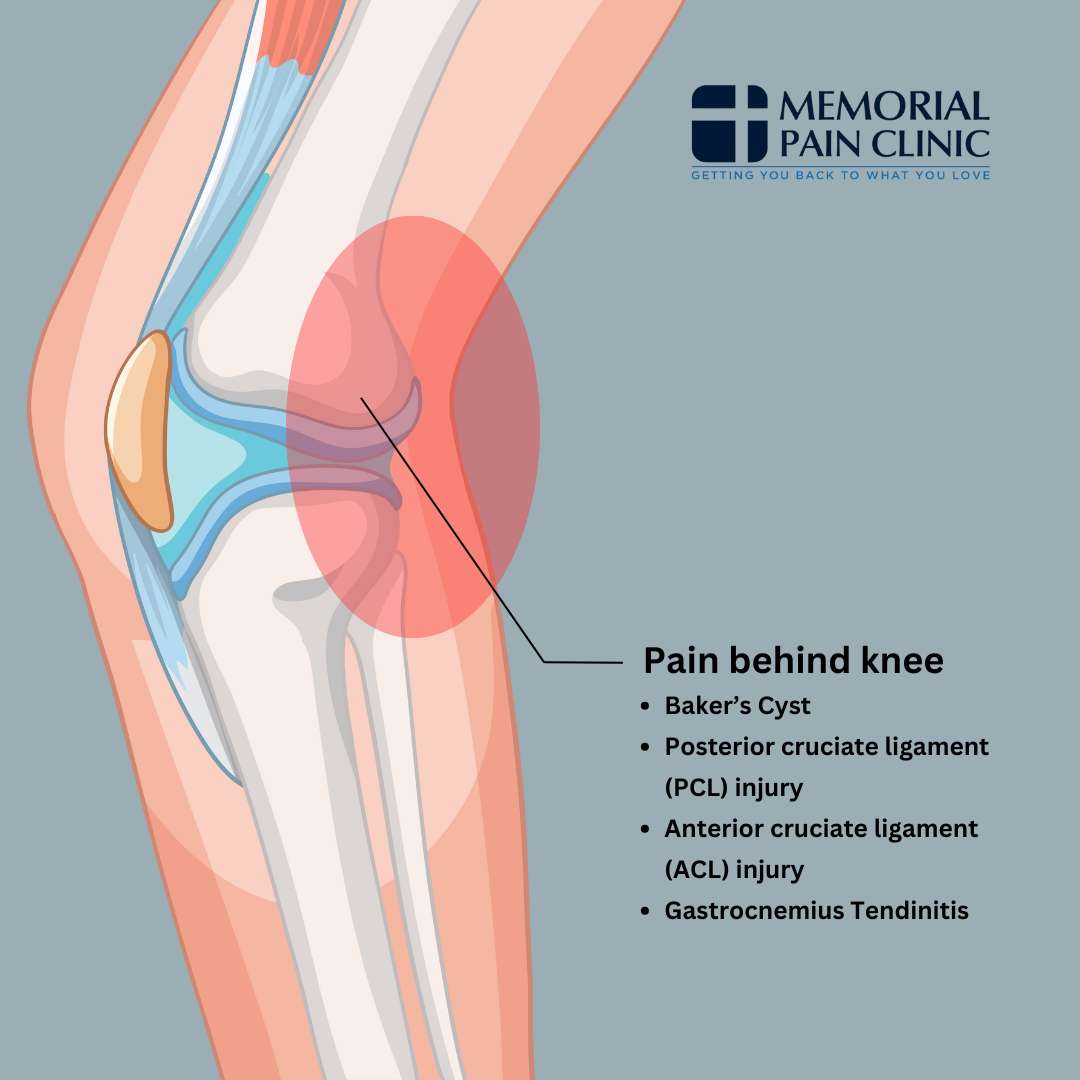
This knee pain location chart shows common causes of pain that occur in the back of the knee:
Baker’s Cyst
A Baker’s cyst, or popliteal cyst, is a fluid-filled lump that forms at the back of the knee. It can cause discomfort, tightness, and pain, especially when you bend or straighten your leg. Baker’s cysts often develop because of other knee problems, like arthritis or a torn meniscus, which cause extra fluid to build up in the back of the knee.
ACL or PCL Injuries
Anterior cruciate ligament injuries (ACL) or posterior cruciate ligament injuries (PCL) are common in sports and usually happen from sudden, forceful movements.
An anterior cruciate ligament injury, such as an ACL tear, causes severe pain and makes the knee feel unstable. A “popping” sound can sometimes be heard when the injury happens. A posterior cruciate ligament injury also causes pain and swelling at the back of the knee and can lead to ongoing problems if not treated. PCL and ACL injuries typically occur during sports or activities involving quick stops, twists, or impacts.
At Memorial Pain Clinic, we offer sports injuries treatment to help you get back on your feet after an ACL or PCL injury.
Gastrocnemius Tendinitis
Gastrocnemius tendinitis happens when the gastrocnemius muscle, a major calf muscle, gets inflamed, causing pain at the back of the knee joint. This condition often results from overuse or too much strain on the calf muscles, especially during activities like running or jumping.
Inner Knee Pain (Medial Knee Pain)
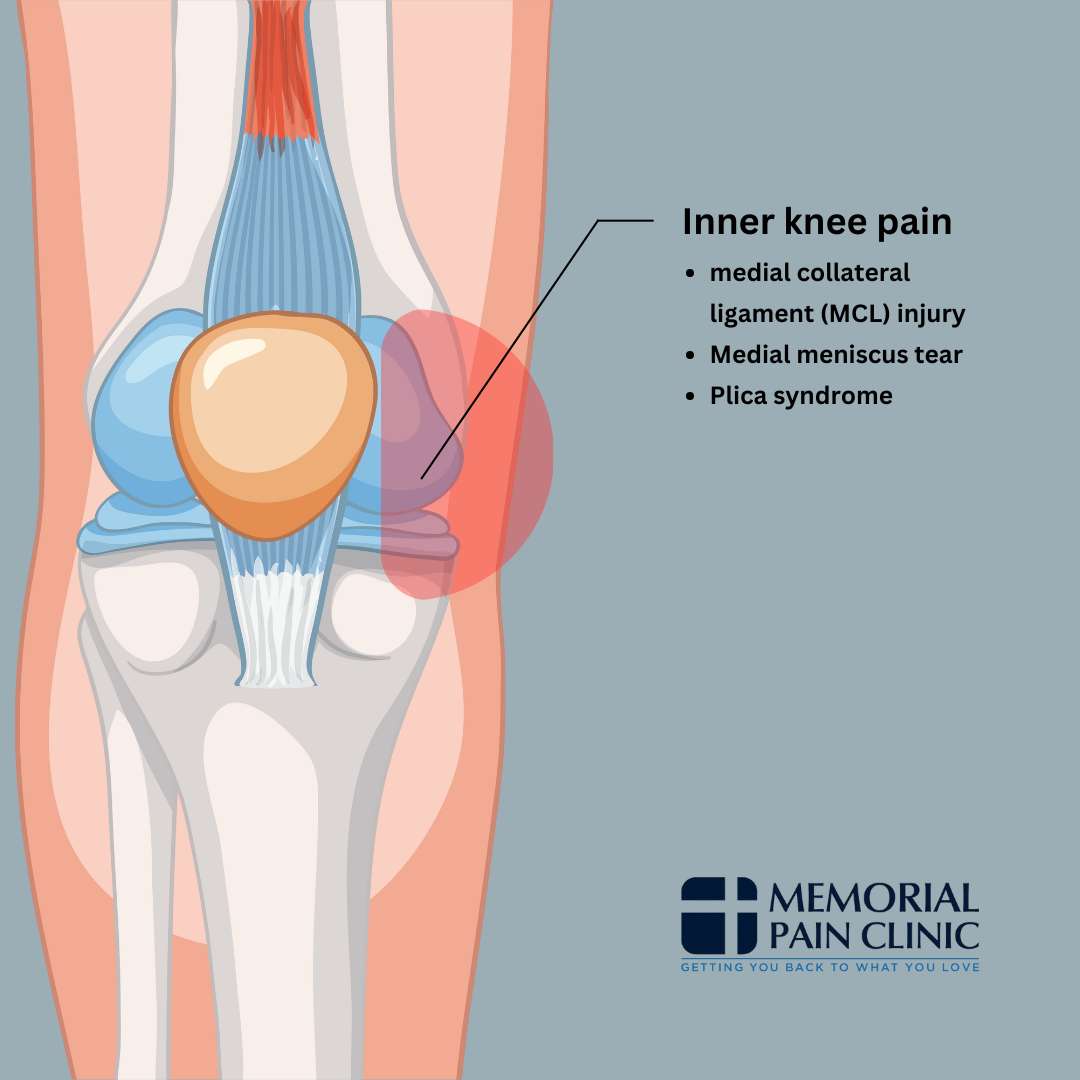
MCL Injury
Medial collateral ligament injuries (MCL injuries) happen when the ligament on the inside of your knee gets stretched, torn, or damaged.
Medial collateral ligament damage can occur from a traumatic injury, like a blow to the knee. MCL injuries often cause intense pain, swelling, and a feeling of instability. MCL injuries are common in contact sports but can also happen during accidents or falls.
It’s important to treat these injuries properly to ensure they heal and don’t lead to further problems.
Meniscus Injury
A meniscus injury involves tears in the cartilage that cushions your knee joint. If the tear is on the inside of the knee, it’s called a medial meniscus tear; if it’s on the outside, it’s a lateral meniscus tear.
Medial and lateral meniscus tears can happen suddenly from twisting or turning, especially during sports, or they can develop over time from the natural wear of the knee joint. Both lateral and medial meniscus tears can cause pain, swelling, and difficulty moving the knee, so it’s important to get them treated to avoid long-term issues.
Plica Syndrome
Plica syndrome occurs when a small fold in the lining of your knee joint, called the plica, gets irritated and inflamed due to repetitive knee movements. This can cause pain on the inner side of your knee, especially during activities that involve a lot of bending and straightening. While plica syndrome is often overlooked, it can cause significant discomfort if not treated.
Outer Knee Pain (Lateral Knee Pain)
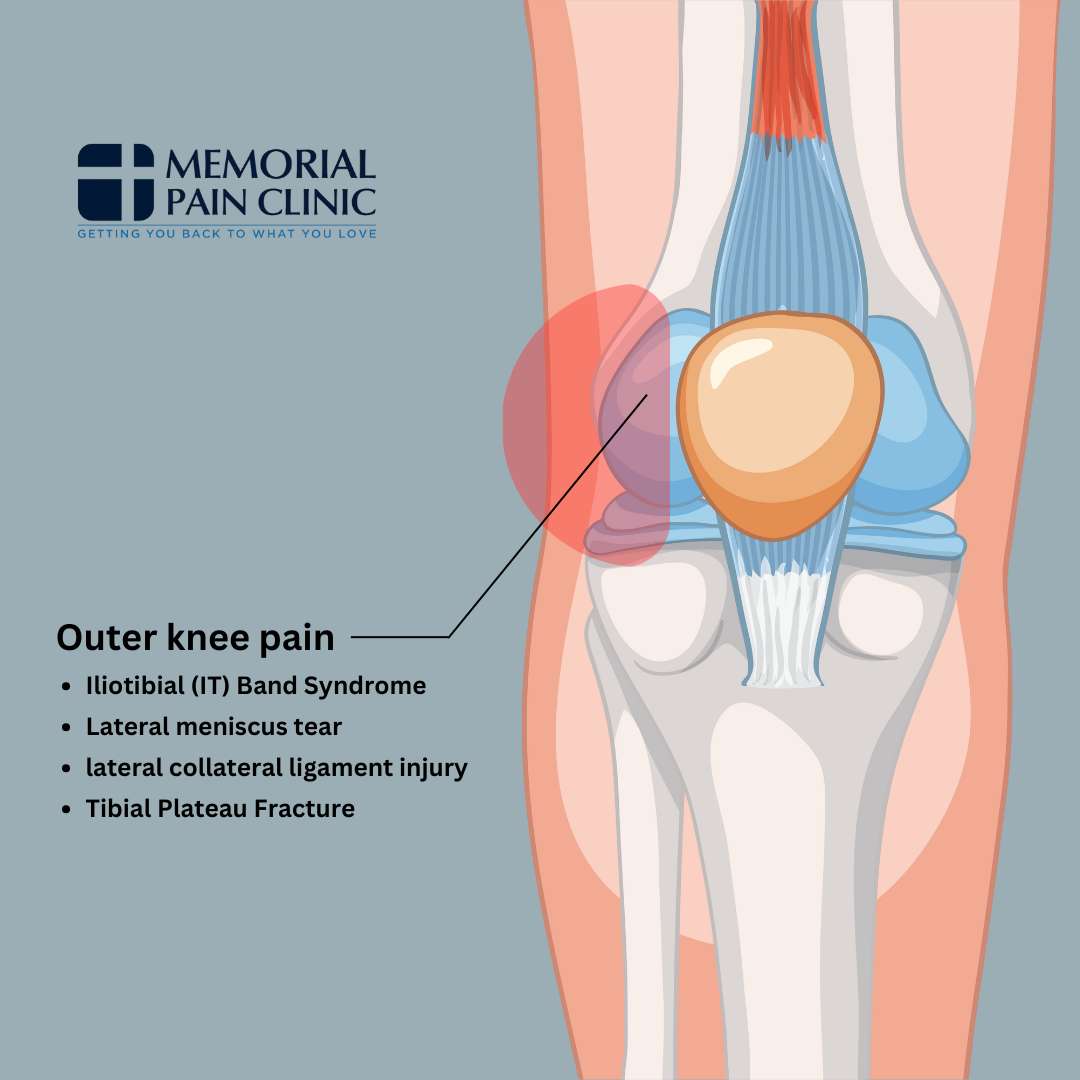
Outer knee pain can be quite uncomfortable and may interfere with your daily activities. Here, we’ll discuss three common causes of outer knee pain:
Iliotibial (IT) Band Syndrome
Iliotibial band syndrome is a frequent cause of pain on the outside of the knee, especially in runners and cyclists. The IT band is a thick strip of tissue that runs from your hip to your knee along the outside of your thigh. When this band becomes tight or irritated, it can rub against the outer part of the knee, leading to pain and swelling.
LCL Injury
A lateral collateral ligament injury (LCL injury) occurs when the ligament on the outside of your knee, known as the LCL ligament, gets stretched, torn, or damaged. This type of knee injury usually happens from a direct blow to the inner knee, which pushes it outward.
Lateral collateral ligament injuries can cause pain, swelling, and a feeling of instability on the outer side of the knee. Treating these injuries right away is important to prevent long-term issues with knee stability and movement.
Tibial Plateau Fracture
A tibial plateau fracture is a break in the upper part of the shinbone, where it meets the knee joint. This kind of fracture can cause a lot of pain on the outer side of the knee and often happens due to a high-impact injury, like a fall or car accident.
A tibial plateau fracture can cause swelling and bruising, and make it hard to put weight on the affected leg. Treatment usually involves surgery, followed by physical therapy to help you regain strength and mobility in your knee.
When to Contact a Doctor About Your Knee Pain
If you’re dealing with severe knee pain or if the pain doesn’t go away after resting and trying home treatments, you should consider seeing a pain management provider at Memorial Pain Clinic.
Knee pain that sticks around or makes it hard to go about your day might be a sign of a more serious problem that needs professional care. If physical therapy isn’t helping, or if the pain is constant, it’s a good idea to look into chronic pain treatment to get the help you need.
How Is Knee Pain Diagnosed?
At Memorial Pain Clinic, our board-certified pain management providers use a compassionate and personalized approach to diagnose your knee pain. Here’s how we do it:
- We Listen to You:
- We start by talking with you about your knee pain—when it started, what makes it worse, and if you’ve had any injuries or conditions in the past that might be causing it.
- We want to understand how the pain is affecting your daily life, so we can provide the best care possible.
- We Examine Your Knee:
- A provider will carefully examine your knee, checking for swelling, tenderness, and how well it moves.
- We’ll do some gentle tests to see if we can pinpoint the exact spot causing your pain and to assess the stability of your knee joint.
- We Use Imaging Tests if Needed:
- If we need more information, we might recommend imaging tests like X-rays or an MRI.
- These tests help us get a detailed look at what’s happening inside your knee, such as any issues with the bones, ligaments, or other soft tissues.
- We Might Suggest Lab Tests:
- If we think an infection or an inflammatory condition like rheumatoid arthritis might be involved, we could suggest blood tests or other lab work.
- We Create a Personalized Treatment Plan:
- Based on all the information we gather, we’ll make an accurate diagnosis and develop a treatment plan that’s tailored just for you.
- Our goal is to relieve your pain and help you get back to doing the things you love.
Contact Memorial Pain Clinic for Knee Pain Treatment in Tulsa, OK
If you’re dealing with knee pain and need relief, don’t wait to get the help you deserve. At Memorial Pain Clinic in Tulsa, Oklahoma, we’re committed to making sure you feel understood, supported, and cared for every step of the way. Our compassionate team provides personalized pain management so you can get back to what you love without knee pain holding you back.
Call 918-200-9944 or contact us online to schedule a visit today.

